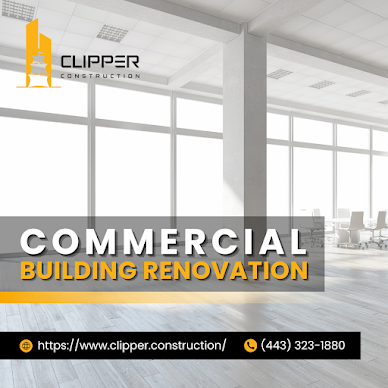What are the Primary Factors to Keep in Mind When Planning a Commercial Building Renovation?
Commercial building renovation is an essential aspect of maintaining and improving the condition of any business property. Renovating a commercial building requires a great deal of planning and consideration, considering various factors to ensure that the process is successful. There are several primary factors to keep in mind when planning a commercial building renovation, including the specific needs of the building, the budget and timeline for the project, and the environmental impact of the renovation. Whether you are renovating a small office building or a large-scale commercial facility, understanding these primary factors is crucial to ensure that your renovation project is a success. In this blog post, we will delve into the essential factors to consider when planning a commercial building renovation to help you make informed decisions when undertaking your renovation project.
Primary Factors to Keep in Mind When Planning a Commercial Building Renovation
Commercial renovation is a major decision for any
business owner and needs to be approached with careful consideration. There are
several primary factors to keep in mind while considering commercial renovation,
which are outlined in detail below:
1. Purpose of the Renovation
The first and foremost factor to consider is the
purpose of the commercial renovation. It's crucial to identify the specific
goals and objectives of the project before embarking on it. This will help you
prioritize the various aspects of the renovation, such as design, materials,
and costs.
2. Budget
Budget is another critical factor that should be
considered while planning for a commercial renovation. It's essential to
determine the amount of money that can be allocated to the project and create a
plan that fits within that budget. One should be mindful of the costs
associated with potential changes to the plans and design.
3. Time Frame
The third factor to keep in mind is the time frame for
the renovation. It's crucial to determine how long the renovation will take and
plan accordingly to prevent delays and additional costs. One should consider if
it's necessary to shut down business operations during the renovation, or if
work can be completed in phases to minimize disruption.
4. Building
Codes and Regulations
Before beginning any commercial renovation project,
it's essential to be familiar with building codes and regulations in the
targeted renovation area to ensure compliance. It's crucial to consult with
local authorities or building inspectors to avoid future legal issues or
damages.
5. Safety and
Accessibility
It's necessary to prioritize the safety and
accessibility of the commercial space during the renovation. One should take
steps to ensure that the renovated space will meet all necessary safety
requirements, guidelines, and regulations. Additionally, one should ensure that
there is proper accessibility and accommodations for all individuals.
6. Quality
Materials
It's important to invest in high-quality materials
during a commercial renovation. High-quality materials can help ensure the
durability and longevity of the finished product, as well as prevent future
costs associated with repairs and replacements.
Overall, it's essential to consider each of these
primary factors carefully during a commercial renovation to achieve the desired
outcomes and ensure long-term success.
Benefits of Renovating Your Commercial Building
Renovating your commercial building may seem like a daunting
task, but it can bring many benefits to your business. Here are some of the
advantages of renovating your commercial building:
Improved Aesthetics
Renovating your commercial building can improve your
building's aesthetics and make it more attractive to clients. A well-maintained
building reflects a positive image, which can translate to increased business
opportunities.
Increased Property
Value
Renovating your commercial building can increase the overall
value of your property. By updating the façade and interior of your building,
you can command higher rent or sales prices, making for a great return on
investment.
Increased Energy
Efficiency
Renovating your commercial building can bring significant
energy-efficient upgrades. Consider installing new HVAC systems, LED lighting,
and energy-efficient windows to cut down on energy costs. By upgrading to
sustainable technologies, you can also demonstrate a commitment to
environmental stewardship.
Improved Safety
Renovating your commercial building can update the safety
features of your building. Installing modern fire alarm systems or sprinklers,
upgrading electrical wiring and plumbing, and improving accessibility for
individuals with disabilities can improve safety and accessibility for all
occupants and visitors.
Increased Employee
Productivity
Renovating your commercial building can boost employee
morale and productivity. Upgrading your HVAC system and lighting can lead to
increased comfort, which can lead to higher job satisfaction. Studies have
shown that natural light and an overall aesthetically pleasing environment can
lead to higher productivity.
Increased Space
Utilization
Renovating your commercial building can help you optimize
your building's space. Reorganizing the layout of your building can free up
more space, giving you the option to expand your business or take on more
employees.
Renovating your commercial building can bring numerous
advantages to your business, from increased property value to improved employee
productivity. While it requires an initial investment, the benefits of a
well-planned renovation can create long-term value for your business.
Steps to Take Before Starting the Project
Renovating a commercial building is a significant investment
that requires careful planning and preparation. Before you begin, it's
important to take the necessary steps to ensure a successful project. We will
discuss the key steps you should take before starting a commercial building
renovation.
1. Conduct a
comprehensive evaluation of the building
The first step in any renovation project is to conduct a
thorough evaluation of the building. This evaluation should include a detailed
analysis of the building's structural integrity, electrical and plumbing
systems, HVAC systems, and overall condition. This will help you identify any
potential issues or challenges that may impact the renovation process and
budget.
2. Define your
renovation goals and objectives
Once you have a clear understanding of the building's
condition, it's time to define your renovation goals and objectives. This
should include a detailed list of all the changes you wish to make to the
building, such as cosmetic upgrades, changes to the layout, or improvements to
energy efficiency.
3. Establish a budget
One of the most critical steps in any renovation project is
establishing a budget. This should be done early in the planning process and
should take into account all expected costs, including materials, labor,
permits, and any unexpected expenses that may arise.
4. Hire a reputable
contractor
To ensure the success of your renovation project, it's
essential to hire a reputable contractor with experience in commercial building
renovations. Look for a contractor who has a solid track record of delivering
high-quality work, good communication skills, and a commitment to completing
projects on time and within budget.
5. Obtain the
necessary permits and approvals
Before you can begin any renovation work, you will need to
obtain the necessary permits and approvals from local authorities. This process
can be time-consuming and complicated, so it's essential to start early and
work with a contractor who has experience navigating the permit process.
6. Develop a detailed
project plan
Once you have completed all the initial steps, it's time to
develop a detailed project plan. This plan should include a comprehensive
timeline, budget, and specific details on what work will be done, who will do
it, and when it will be completed.
Different Approaches to Consider for Your Renovation
When planning a commercial building renovation, there are
different approaches that one can consider depending on factors such as the
scope of the project, budget, and desired outcomes. Here are several approaches
you might consider for your renovation project:
- Retrofitting: This approach involves modifying or updating existing building systems and structures to improve functionality, energy efficiency, and sustainability. Retrofitting may include upgrades to lighting, heating, ventilation, and air conditioning (HVAC) systems, insulation, roofing, and windows. This approach is often cost-effective and helps businesses reduce operating costs and environmental footprints.
- Adaptive Reuse: This approach involves repurposing an existing building or facility for different uses than it was originally intended. Adaptive reuse can be a creative solution for projects where demolition or a complete rebuild is not feasible or desirable. Examples of adaptive reuse for commercial buildings could include converting an old warehouse into an office space or a former bank building into apartments.
- Restoration: Restoration involves returning a building to its original design and condition. This approach is ideal for historic buildings or structures that possess architectural or cultural significance that should be preserved. Restoration work involves addressing any functional or structural issues while retaining the original character and design elements of the building.
- Build-to-Suit: This approach involves constructing a new building or facility to meet specific needs and requirements. This approach can be more costly than retrofitting or adaptive reuse, but it provides greater flexibility and customization options. Build-to-suit projects are often used in commercial real estate development when a tenant requires a specific type of building or space to operate their business.
- Phased Renovation: This approach involves renovating a building in phases, instead of all at once. This approach can be helpful for businesses that need to remain open during the renovation process, allowing for minimal disruption to operations. Phased renovation also allows businesses to focus on specific areas or systems in the building as budget and priorities allow.
The approach you choose for your commercial building
renovation will depend on your specific needs and circumstances. By considering
these different options, you can make an informed decision that will help you
achieve your desired outcomes.
Conclusion
In conclusion, commercial building renovation is a necessary
process in maintaining the structural integrity and aesthetic appeal of a
property. It provides a great opportunity for businesses to enhance their
space, add value to their property, and create a safer, more efficient working
environment. With the right professionals and resources, a successful
renovation can be achieved within budget and on time. It is therefore
imperative for business owners and property managers to prioritize regular
renovations and upkeep to ensure long-term success and sustainability.

